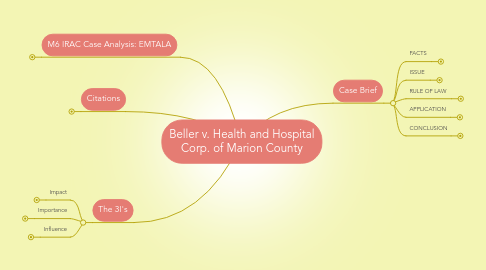
1. M6 IRAC Case Analysis: EMTALA
1.1. Joshua BELLER, a minor, by his next friend and mother, Melissa WELCH, et al., Plaintiffs–Appellants, v. HEALTH AND HOSPITAL CORP. OF MARION COUNTY, INDIANA, d/b/a Wishard Memorial Hospital, d/b/a Wishard Ambulance Service, Defendant–Appellee. No. 11–3691. Decided: December 20, 2012
2. Citations
2.1. Findlaw for Legal Professionals http://caselaw.findlaw.com/us-7th-circuit/1618704.html
2.2. Horty Springer Beller v. Health and Hosp. Corp. of Marion County, Ind. (Summary) https://www.hortyspringer.com/documents/beller-v-health-and-hosp-corp-of-marion-county-ind-summary-2/
2.3. The Judicial Review https://www.judicialview.com/Court-Cases/Torts/Welch-v-Health-and-Hospital-Corp.-of-Marion-County-Indiana/44/569027
2.4. An Ambulance ‘Owned’ by a Hospital Must Also Be ‘Operated’ by the Hospital to Trigger EMTALA Obligations
2.5. https://www.greensfelder.com/media/event/237_Lepper-MHA-EMTALA-2016.pdf
2.6. FAQ on EMTALA
2.7. Report Says Ambulances Steer to Their Own Hospitals
2.8. Ambulance Services in the US Market Research | IBISWorld
3. The 3I's
3.1. Impact
3.1.1. One impact has been the privatization of ambulance services to mitigate costs. IBIS attributes the shift to CMS reimbursement, but there may be value in considering the regulations of EMTALA, which can directly impact financial resources.
3.2. Importance
3.2.1. Private v. Hospital owned: EMTALA does not apply to a hospital-owned ambulance when the ambulance is operating under communitywide protocols that require it to transport an individual to a hospital other than the hospital that owns the ambulance.
3.3. Influence
3.3.1. The definition of "stabilized" was further clarified in a 2003 and 2008 DHHS amendment. EMTALA obligations end once the patient is stabilized. Even if a subsequent condition arises, EMTALA is not retroactive.
4. Case Brief
4.1. FACTS
4.1.1. Parties
4.1.1.1. Minor, Joshua, 34 weeks gestation at birth & mother, Melissa Welch
4.1.1.2. Wishard Memorial Hospital, dba Wishard Ambulance Service
4.1.2. What Happend
4.1.2.1. Melissa Welch, 34 weeks gestation calls 911 and Wishard Ambulance Service responds to the call
4.1.2.2. Wishard Ambulance Service diagnosis ruptured membranes and prolapsed umbilical cord.
4.1.2.3. Following consult with Welch's OB nurse, care team decided transport to NEAREST hospital was prudent
4.1.2.4. Beech Grove ER, the nearest hospital, but with no OB services, examined Welch and discharged her to the Wishard Ambulance Service for transport to St. Francis Hospital South
4.1.2.5. Minor, Joshua, was delivered at St. Francis Hospital South by C-section with severe brain damage due to lack of oxygen
4.1.3. Procedural History
4.1.3.1. A) Plaintiff files suit against Wishard alleging EMTALA violation for failure to stabilize during emergency
4.1.3.2. Summary judgement granted to Wishard; plaintiff appeals
4.2. ISSUE
4.2.1. The courts must define what "come to the emergency room" means for a hospital
4.2.2. Decide if the 2003 definition from the DHHS applies retroactively
4.3. RULE OF LAW
4.3.1. Agencies may not promulgate retroactive rules unless it has express authority from Congress. In addition, retroactive application must be specified in subsequent amendment
4.4. APPLICATION
4.4.1. Physicians
4.4.1.1. Incorrect Diagnosis
4.4.1.1.1. In the case: Urban v. King, 834 F Supp 1328 (1993) the courts held that EMTALA does not apply for erroneous diagnosis if the physician misdiagnosis an emergency medical condition. In the case of misdiagnosis, the plaintiff should expect to claim negligence for failure to make a diagnosis according to industry practices.
4.4.1.2. Protection against EMTALA
4.4.1.2.1. In the case: Jones v. Wake County Hospital System, Inc., 786 F.Supp. 538 (E.D.N.C. 1991) the courts established the "key" to protection was having an established triage procedure. The triage procedure must be followed consistently, and without regard to insurance status. In essence, this case established that even if the screening protocol is inadequate, it does not violate EMTALA.
4.4.2. Hospitals
4.4.2.1. ER Protocols, Policies, and Procedures
4.4.2.1.1. STABILIZED: Understand definition of "stabilized" under EMTALA for pregnant women: (for patients in active labor) the infant and the placenta have been delivered. In the case of Beller, she would be considered to be in active labor if her membranes ruptured. However, this interpretation is open to clinical interpretation, since active labor can be defined by cervical dilation, presentation of fetus, distress, or frequency of contractions.
4.4.2.1.2. TRIAGE: In the case: Jones v. Wake County Hospital System, Inc., 786 F.Supp. 538 (E.D.N.C. 1991) the courts established the "key" to protection was having an established triage procedure. The triage procedure must be followed consistently, and without regard to insurance status. In essence, this case established that even if the screening protocol is inadequate, it does not violate EMTALA.
4.4.2.2. EMTALA Application
4.4.2.2.1. 250 Yard Rule: Patient is considered to be on the property if patient is within 250 yards of main hospital and part of hospital premises (premises would also include inside of a hospital owned ambulance).
4.4.2.2.2. Lay person: Even if there is no diagnosis of an "emergency," if the patient is at the hospital and 1). requests an exam, or 2) a lay person would consider patient in state of emergency, EMTALA applies
4.4.2.2.3. Ownership: For EMTALA to apply, the ambulance must be ‘Owned’ and "operated" by the hospital
4.5. CONCLUSION
4.5.1. Summary judgement affirmed by appellate court
